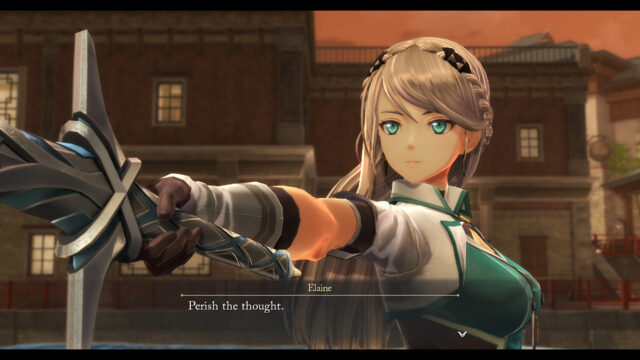The Legend of Heroes: Trails through Daybreak Preview
The Legends of Heroes: Trails through Daybreak marks an exciting new step for the series, as it looks at providing a very welcome new jumping on point for new players, while offering plenty of fresh elements and exciting changes to its ardent fans.
After a lengthy stay in Erebonia and Crossbell, Nihon Falcom’s The Legend of Heroes heads to new ground in the west with the release of The Legend of Heroes: Trails through Daybreak in July. Ahead of the release of the game — and its upcoming demo — publisher NIS America offered RPGamer a chance to see the game’s fresh setting as some of the major changes it makes to the series formula.
The Legend of Heroes series offers players plenty of starting points, and Trails through Daybreak is intended to act as its latest with the start of its Calvard arc. The game features a brand new setting, taking place in the more modern-day styled Republic of Calvard, as well as a new protagonist in Van Arkride. While it does follow from the events of the previous games, beginning a year after the events of Trails into Reverie, Trails into Daybreak is the start of its own story and, like other titles in the series, important elements that do carry over are set to be explained and brought into proceedings naturally through the course of the game.
Following events of the past year, Calvard has been experiencing a technological and economic boom as a result of events covered in the Erebonia saga. However, there is still concern and bubbling unrest as the country trying to continue its growth and handle immigration. Nihon Falcom has intentionally made the game’s backdrop a bit more morally dubious and more mature with some of its story elements. There are some definite Chinese influences in the game, with the section NIS America showing the Calvard capital’s Eastern Quarter as well as a story dungeon involving party member Aaron Wei that draws visual comparisons to the Kowloon Walled City.
Although a lot of his work is structurally similar to those of the Bracer Guild, Special Support Section, and Class VII, Van is also a bit of departure from previous protagonists. Rather than working for any organisation, he is wholly independent as a “spriggan”. He also takes on work that most legitimate sources is unable to for whatever reason, which can put him on the wrong side of the law. His greyer morality works hand in hand with the game’s new alignment system. The other main character is Agnès Claudel, a first year student at Aramis Academy who comes to Van with a request that ends up being more than he anticipated.
Trails through Daybreak’s alignment system puts a bit more agency in the hands of the players. As they progress through the game, they will be able to make choices through both the main story and sidequests that affect Van’s values for Law, Gray, and Chaos. These values will impact certain segments and see different characters joining up with Van for these sequences, giving players a bit more involvement and the game an extra element of replay value. One example of a choice players can make concerns a bicycle thief where players can choose to turn him over to the police or to work off a debt to the victim. These choices will not necessarily be wholly in one direction or another; some will give some points towards one alignment and a small amount to another.
Also coming in fresh to Trails into Daybreak is a revamp of the series’ combat system. While all boss battles are still exclusively presented in the latest iteration of its turn-based combat, the game introduces new action-based Field Battles for all regular encounters where players can seamlessly switch from action combat to the traditional turn-based system. How this is likely to work in practice is that players will use real-time attacks to stun enemies, then switch to turn-based mode within that encounter to take advantage of that. In Field Combat, characters have access to regular three-hit combos and a dodge action. As they strike enemies, a meter will build up and when activated this will unleash the special attack that will often cause a stun; however, if players are knocked down during this then the enemy will gain an advantage as it transitions into turn-based combat. From what NIS America showed of the new combat, it will make a welcome change to exploring dungeons, making the experience much more dynamic and keeping players fully engaged throughout.
The turn-based combat retains the same basics from the previous games, though there are small tweaks that add up. Characters go individually based on a turn-based displayed at the top of the screen. Certain positions have an icon underneath them that indicates they will receive a boost for that turn, such as a guaranteed critical hit or free healing. Each turn characters can use an action — including the regular Arts, Crafts, and items options — but this time around they can freely move within a certain distance on their turn.
Positioning is still important, but arguably even more so here. Many skills in Trails through Daybreak will be more effective if they strike from the side or rear, while characters will now link and do follow-up attacks only if they are positioned close to one another, making activating them more of a risk-versus-reward as it gives enemies more opportunities with area-of-effect skills. Another tweak to combat is the addition of S-Boosts, a gauge that rises as combat goes on and works with the game’s Orbment loadout system to provide boosts for a certain period, as well as being required for the all-powerful S-Craft special moves. It’s also worth noting that the menu system is designed to be less reliant on heavily-nested menus and let players select actions with fewer button presses.
The latest generation Orbments, known as Xipha and looking even more like modern smartphones, also revamp how skills and arts are assigned to party members. Arts are no longer provided by equipping relevant Quartz; they are instead determined by the Arts Driver, which comes pre-equipped with different Arts. However, there are a few additional slots where players can add specific Arts to supplement their abilities. Orbments also have a Hollow Core, which offers significant passive boosts to the character when they activate their S-Boost in combat. Characters are still designed to fulfill certain roles in combat — Van is more of a tank — and players are encouraged to build their characters around these. Trails through Daybreak offers the usual difficulty level options that series fans will expect to accommodate players of all skill levels.
Quartz are still used in Trails through Daybreak, but are now wholly devoted to passive effects. Each Xipha Orbment has four lines that evoke a microchip corresponding to attack, defence, action, and extra bonuses. By assigning Quartz to each line, players will unlock various boosts and effects known as Shard Skills to that character based on the elemental values of the Quartz. Players can see what effects can be unlocked at any time, helping to plan their loadouts, as some of the higher-level Shard Skills require forethought to access. These effects will come with a percentage chance of being activated, but this chance is significantly boosted when using S-Boosts, making it an important element to master and an area where players can generate a huge amount of synergy within a single character.
Other changes include a rework of how the game’s cooking system works. It once again offers players healing opportunities as well as extra passive boosts to the party, but encourages more consistent use through Gourmet Points. Whenever the party eats, they will gain points that will lead to a rank up that provides an additional bonus, such as +10 defense points to all party members. This is designed to help prevent unnecessary stockpiling, as well as to explore locations and find whatever foods they have available, because many foods will only be found in certain areas.

Trails through Daybreak offers a whole host of new characters to get to know, plus some returning faces.
Meanwhile, the general structure of quests and sidequests remains largely the same as in previous titles, where Van will get additional optional requests to deal with. There will also be returning connect events, where Van has the opportunity to bond with party members, providing more info about their backstories and personalities as well as giving them stat boosts, but won’t be able to hit all possible options in a single playthough. NIS America did also note that, unlike Trails of Cold Steel, all of these events are not romantic in nature. Although there is an in-game achievement system, there’s a bit less of a collectathon nature; multi-part books are largely gone with the side stories they offered replaced by films, which players can watch while connecting with other characters. Players who complete most of the available content can expect to spend around 80-100 hours on a playthrough.
Another area NIS America highlighted is the upgrade in graphics engine. Trails through Daybreak utilises a new engine that was previous in one specific scene at the end of Trails into Reverie. The new engine showcases enhanced lighting, reflections, and textures, although it is notable that shadows aren’t necessarily as pronounced as they might be on other contemporary titles. It’s an appreciable upgrade, while maintaining the same look and feel that fans have become familiar with. The new stylings on Trails through Daybreak’s UI also look very nice; the game’s combat screen managed to pack a huge amount of information on there, though there are reasonable concerns that some things will be hard to read on smaller screens.
The Legends of Heroes: Trails through Daybreak marks an exciting new step for the series, as it looks at providing a very welcome new jumping on point for new players, while offering plenty of fresh elements and exciting changes to its ardent fans. Players will be able to try it out for themselves when the demo launches on PlayStation and Switch consoles next week, with the full release coming to PC, PlayStation 4, PlayStation 5, and Nintendo Switch on July 5, 2024.


















Recent Comments